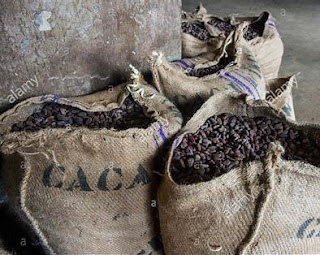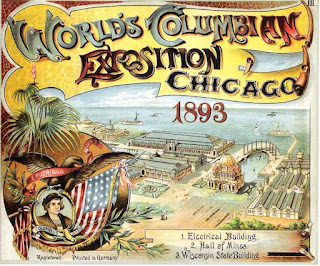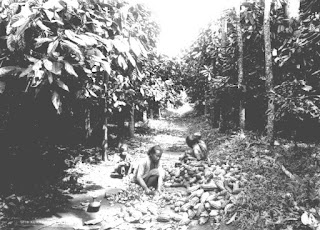CACAO IN MODERN TIMES: PRODUCTION
Modern technology and diversification inspired by the Industrial Revolution drove chocolate consumption up, and with it a high demand for raw cacao. However, independence in Latin America curtailed main producing regions and forced chocolate producers to seek alternative cacao sources. Cadbury, one of the main chocolate companies to benefit from technological modernization, began purchasing its cacao from Africa. Demands of modernization for cheap cacao from outside sources created a moral and political dilemma for chocolate companies like Cadbury.
When Brazil achieved independence from Portugal in 1822, the Portuguese simply brought cacao seedlings and their slave-labor, large-plantation model of production to Sao Tome and Principe, Portuguese colonies off the West Coast of Africa, and resumed business. The abolishment of slavery in Portuguese colonies in 1869 forced plantation owners to redefine labor recruitment as a new model they called “contract labor” to assuage European importers. Cadbury began importing its cacao from Sao Tome in 1886, the world’s third largest exporter of cacao beans at the time, unaware of the ethical clash between buyer and seller.
Cadbury prided itself as being a socially conscious business from the roots of their supply chains to the final product—or so they thought. The company held loyal to their principles as Quakers in their social image and treatment of labor in England. Cadbury advertisements promoted a diverse selection of chocolate products under a brand name known and respected as pure and progressive. They paid their factory workers in England relatively high wages, provided clean and well-organized working conditions, and built Bournville, a “garden factory” village for workers. However, in 1901 William Cadbury came across an advertisement for the sale of a Sao Tome plantation that questioned his understanding of Portuguese labor recruitment. The sale included tools, cattle, and laborers—an indication that the owner considered workers property on an equal level with animals. Cadbury had heard indirect rumors of slave labor in Sao Tome. Concerned by his company’s ignorance on the matter, the ad led him to investigate.
William Cadbury’s search for the truth about labor conditions in Sao Tome drew in politics. During a trip to Lisbon in 1903, Sao Tome plantation owners and the Portuguese Minister of Marine and Colonies assured Cadbury that a newly instituted labor decree would secure the end of labor abuses and guarantee repatriation for workers. When he came home and suggested that a company representative travel to West Africa to confirm execution of the new regulations, the English government balked. England and Portugal were allies, with Portugal providing the labor source for British mines in South Africa and Rhodesia. England worried about angering the Portuguese and asked Cadbury to give Portugal a year to sort out the regulations. Cadbury waited out the year with no apparent results, then warned the English Foreign Office that his company would pay a higher price elsewhere if it meant stopping a disguised slave trade. At the end of the year, Cadbury notified its competitors Fry and Rowntree of the situation and asked for their support in hiring a private investigator to visit Sao Tome. As high volume needs threatened to put a public spotlight on the labor distinctions between producers of chocolate in England and the producers of cacao in Portuguese West Africa, Cadbury—who purchased fifty-five percent of its cacao from San Tome—began to seek out other potential suppliers to save the company from embarrassment.
Cadbury’s worries about the moral labor discrepancy going public came to fruition in 1906. Investigative reporter Henry Nevinson had done what the British government checked Cadbury from doing—he travelled to Sao Tome to study labor conditions on the ground in person. His experience resulted in a series of articles in Harper’s magazine between 1905 and 1906 that exposed the public to the horrific truth. Sao Tome’s “contract labor” system was nothing more than slavery in disguise. Illiterate workers signed five-year contracts as servicais free to go home when the contract expired. But of the fifty percent of workers that even lived out their contracts, no one ever returned home. The captive workforce labored under brutal climate conditions with a yearly adult death rate of twelve to fourteen percent, and a child death rate of twenty-five percent annually. Doctors attributed a large portion of the deaths to “anemia caused by unhappiness.” Nevinson’s articles stirred outrage in Lisbon and England. Joseph Burtt, the private investigator hired by Cadbury, Fry, and Rowntree the same year, corroborated Nevinson’s findings. The British government, unable to retract Nevinson’s exposé, delayed the release of Burtt’s report until 1908 to give Portugal time to address the issues. Meanwhile, newspapers questioned why antislavery Cadbury still bought cacao from Sao Tome, wondering if the happiness of the white workers at Bournville was more important than the well-being of their African counterparts.
Caught in a moral and political dilemma, Cadbury continued its push for solutions. William Cadbury travelled to Sao Tome to see for himself if reforms were instated, then left convinced that the Portuguese government lacked the ability to enforce them. Together with Fry and Rowntree, in 1909 Cadbury announced a boycott on cacao from San Tome and Principe until the establishment of labor reform and repatriation. The boycott brought Portugal’s African labor practices and the plight of its workers to the attention of the world. Indignant at the affront to their integrity, Portugal published counters to criticisms. Their attempts to demonstrate compliance were largely a façade. As a result, Cadbury moved their cacao supply source from Sao Tome to ethically sound British-controlled Ghana with better labor conditions and practice.
The same year, Cadbury sued the Standard, its most brutal critic for libel. In an effort to justify Cadbury’s former use of Sao Tome as a provider and to rehabilitate the company’s public reputation, William Cadbury took the stand in court. He recounted his efforts through the Portuguese Government and the English Foreign Office to obtain better working conditions for laborers in Sao Tome. He testified that when efforts failed, Cadbury moved procurement from Sao Tome to Ghana. The unsympathetic jury awarded Cadbury “contemptuous” damages of one farthing, the lowest possible amount, as compensation for company losses. A sum just short of what a Sao Tome servicais earned in a week. Cadbury won the libel suit with a face slap.
The success of chocolate modernization calling for cheap, outside cacao sources presented chocolate companies like Cadbury with a moral and political dilemma. Cadbury struggled for eight years to resolve the labor conundrum through diplomacy and failed. A cacao embargo against Portugal drew a tepid response. The voice of the public, enraged by a perceived, pitiless hypocrisy of Cadbury’s use of Sao Tome labor, proved an effective weapon toward change. Cadbury’s experience highlights how politics, labor laws, and corporate behaviors dictate the game of global production.
Bibliography:
“Cadbury Brothers and Contract Labour.” Selly Manor Museum, accessed October 16, 2021. https://sellymanormuseum.org.uk/news/2020-10-31/cadbury-brothers-and-the-issue-of-contract-labour
HIS429. Lecture 6. Cacao in Modern Times: Production
Walker, Timothy. “Establishing Cacao Plantation Culture in the Atlantic World.” In Chocolate, 543–58. Hoboken, NJ, USA: John Wiley & Sons, Inc, 2009.




Comments